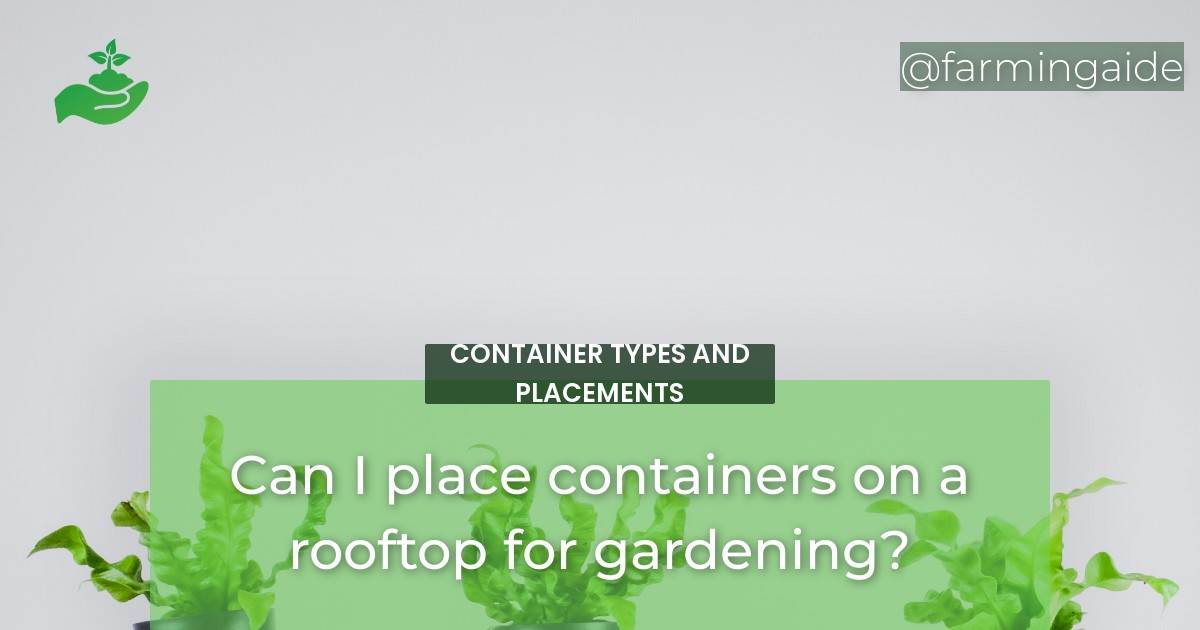Rooftop gardening has gained popularity in recent years as people look for ways to grow their own food in urban areas. One common question that arises is whether containers can be placed on a rooftop for gardening. The answer is yes, but there are several factors to consider before starting a rooftop container garden.
Introduction
Urban gardening has become a trend in recent years, as more people seek to grow their own food in small spaces. Rooftop container gardening is one way to utilize space that would otherwise go unused. With rooftop gardening, you can grow vegetables, herbs, and even fruit trees in containers placed on your rooftop.
The benefits of rooftop container gardening include:
- Utilizing previously unused space
- Improved air quality
- Reduced heat island effect
- Reduced stormwater runoff
- Fresh, homegrown produce
Container Types and Placements
Types of Containers
When it comes to rooftop container gardening, there are several types of containers to choose from:
- Plastic pots
- Terra cotta pots
- Fabric pots
- Wooden planters
- Metal troughs
Each of these container types has its pros and cons. Plastic pots are lightweight, durable, and affordable, but they can also become brittle and crack in extreme temperatures. Terra cotta pots are attractive and provide good drainage, but they can be heavy and break easily. Fabric pots are lightweight and allow for good drainage, but they can dry out quickly and need frequent watering. Wooden planters are attractive and can be customized to fit any space, but they can also rot over time. Metal troughs are sturdy and provide good drainage, but they can be heavy and expensive.
Container Placements
Container placement is an important consideration when it comes to rooftop gardening. The weight of the containers and soil must be taken into account, as well as the amount of wind and sun exposure that the containers will receive. Some possible container placements include:
- Directly on the rooftop
- On a raised platform
- On a trellis or pergola
Each of these container placements has its advantages and disadvantages. Placing containers directly on the rooftop is the most straightforward option, but it requires careful consideration of weight distribution and load-bearing capacity. A raised platform provides more flexibility in container placement, but it can be expensive and may require a building permit. A trellis or pergola provides shade and support for climbing plants, but it also requires careful consideration of wind exposure and load-bearing capacity.
ALSO READ
Feasibility of Rooftop Container Gardening
Structural Considerations
Before starting a rooftop container garden, it is important to consider the structural capacity of the rooftop. Rooftops are designed to support the weight of the building and its occupants, but they may not be designed to support the weight of a garden. The load-bearing capacity of the rooftop must be carefully assessed before starting a rooftop container garden.
Some structural considerations to keep in mind include:
- The weight of the containers and soil
- The slope of the rooftop
- The type of roofing material
- Access to the rooftop
To ensure that your rooftop can support a container garden, it is best to consult with a structural engineer or a professional contractor.
Environmental Considerations
Environmental factors also play a role in rooftop container gardening. Wind, sun exposure, and rainfall can all affect the success of a rooftop garden. It is important to take these factors into account when planning a rooftop container garden.
Some environmental considerations to keep in mind include:
- Wind exposure
- Sun exposure
- Temperature fluctuations
- Rainfall and drainage
To mitigate these environmental factors, it may be necessary to install windbreaks, shade cloth, or irrigation systems.
Plant Selection and Care
Plant Selection
Choosing the right plants for your rooftop container garden is crucial for success. Not all plants are suited for the unique conditions of a rooftop garden.
Some factors to consider when selecting plants for a rooftop container garden include:
- The amount of sun exposure
- The amount of wind exposure
- The size of the containers
- The type of soil
- The climate in your area
Some plants that are well-suited for rooftop container gardening include:
- Tomatoes
- Peppers
- Herbs
- Lettuce
- Radishes
Plant Care
Caring for container plants in a rooftop garden requires some special considerations. Container plants may dry out more quickly than plants in the ground, so it is important to water them regularly. Fertilization is also important, as container soil can become depleted of nutrients over time.
Some tips for caring for container plants in a rooftop garden include:
- Water plants regularly
- Fertilize plants as needed
- Monitor plant growth and adjust container placement as needed
- Prune plants as needed to promote healthy growth
ALSO READ
Conclusion
Rooftop container gardening is a great way to utilize previously unused space and grow your own fresh produce. With careful consideration of container types, placement, structural and environmental factors, plant selection, and care, you can create a thriving rooftop container garden. It is important to consult with professionals as needed to ensure that your rooftop is capable of supporting a container garden. With the right planning and care, you can enjoy the benefits of rooftop container gardening for years to come.
RELATED ARTICLES:


